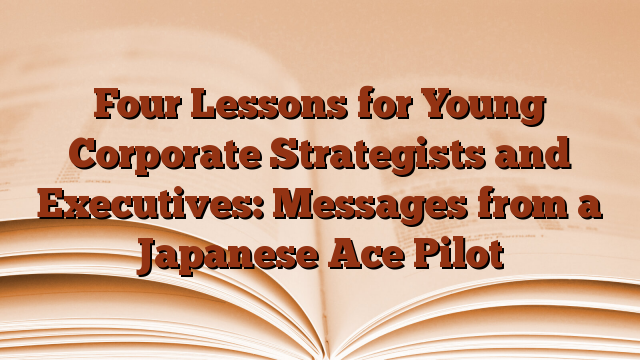Mr. Saburo Sakai (1916-2000) was one of Japan’s leading ace pilots during World War II. His book “SAMURAI” became very popular all over the world. After the war he founded a printing company and acted as CEO. During his tenure as CEO, he was also active as a speaker for young corporate strategies and executives in top executive seminars. He typically gave four lessons to become great strategists and leaders based on his own experiences as a lead fighter pilot as well as a top manager. In this article, we’ll go over the four lessons.
1: Good fighters never lose their temper.
Mr. Sakai said that great strategies would never work if pilots lost their tempers during combat. Aerial combat requires very finely tuned strategies and must always be carefully directed and coordinated. In order to direct and coordinate during real fights, fighters need to keep their cool no matter what. At the same time, pilots must deftly retreat to take a second chance when something goes wrong.
Therefore, pilots were not accused of doing anything to lose second chances by doing stupid things. Above all, they were not expected to lose their tempers in such unwanted and unexpected situations. He saw many pilots lose their temper and perform kamikaze attacks. He always forbade kamikaze attacks on those around him and commanded wiser judgments to be made when things went wrong. His motto was, “Come back alive to fight again.”
Young strategists and executives can learn from this. When they get upset about unexpected and very bad results of their strategies, they can take bad steps like: B. Keep investing in the ineffective strategies to save face. This is because they lose their temper and may not consider (1) when strategies are not appropriate to begin with, (2) when the business environment has changed dramatically, (3) when they can change strategies, to deal with new environments, or (4) when they need to introduce alternative strategies or develop new strategies. Being able to control your temper under all circumstances is the first qualification to be a good strategist or leader.
2: Good fighters make the best possible strategies and move within the capabilities of their aircraft.
Mr. Sakai always said he was trying to do his best within his plane’s capacity. He also said the best strategy would always consider the capabilities of the planes they would be using. For example, if your plane can fly at 360 mph, flying continuously at 400 mph during battles is not a good idea.
Mr. Sakai said that he didn’t make good plays during the fights, even though he could make good plays anytime if he had to. He went on to say that truly great aces would know the capabilities of their planes and strategies within those capabilities, so they would never put themselves in situations where they needed to make good games.
Young strategies and managers can learn from this. If we don’t consider the capacity of your organizations such as human resources, organizational structure, production capacity, quality standard, financial condition, investors, market share, product attractiveness and positions, band names and other things, we cannot develop effective strategies. The worst strategies are designed and implemented on the basis of false assumptions, desires or ideals due to a lack of information about organizations’ actual capacities.
As you strategize, make sure you have all realistic information about your organization’s capabilities. It would be a good idea to also know how previous strategies have worked to get more information about the capacities.
3: Good fighters know the timing and ways of retreat.
Mr. Sakai said he became a true ace pilot as he mastered the timing and manner of retreating from dogfights. So many pilots were shot because they missed the time to retreat or didn’t know how to safely retreat for a second chance.
Young strategists and leaders can learn from this lesson. When you notice your strategy is not working well, you need to know the right ways to withdraw the strategies in time. You must be brave enough to decide to retreat first. Then you need to be able to persuade other executives to estimate lost investments and additional costs of the exit, create a timeline for the exit and make a new strategic plan.
4: Good fighters always respect the idea of ”lower risk with higher performance”.
Mr. Sakai would never take unnecessary risks in dogfights. To reduce risk, he always tried to fight for better performance under preferred (safer) positions. This was his strategic policy of creating a competitive advantage first and competing within the advantage.
Young strategists and executives can learn from this. When planning strategies, risk assessments are essential to ensure reasonable returns. While your strategy can work wonders to generate huge returns in very high-risk environments, finding lower-risk strategies to generate higher returns allows you to be more strategic and safer. There’s nothing wrong if you’re looking for lower-risk strategies to get more returns relative to the level of risk.
Mr. Sakai was a great fighter and air strategist during World War II. Not only was he famous as a Nulljäger ace, but he was also one of the pilots who took part in the final dogfight of World War II on August 17, 1945. Shortly before his death, he was working with former American ace pilots on Microsoft’s computer game Microsoft Combat Flight Simulator 2. If you are interested in Mr. Saburo Sakai’s stories, you might want to read his book SAMURAI.
Thanks to Dr Hideki Takei | #Lessons #Young #Corporate #Strategists #Executives #Messages #Japanese #Ace #Pilot

Leave a Reply